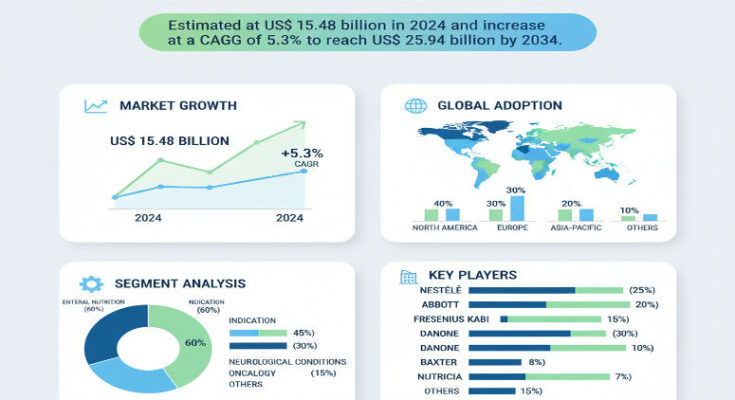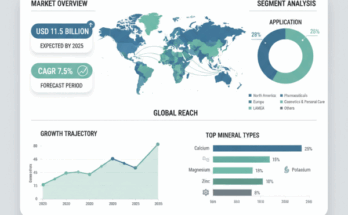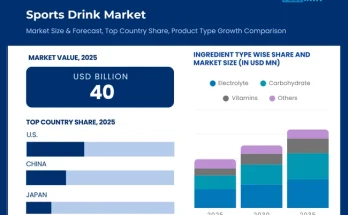The global clinical nutrition market is estimated to be worth US$ 15.48 billion in 2024 and is forecast to grow at a CAGR of 5.3%, reaching around US$ 25.94 billion by 2034. This growth highlights the increasing recognition of clinical nutrition—covering oral, enteral, and parenteral nutrition therapies—as a critical component of patient care in hospitals, long-term care, home-based settings, and disease-specific treatment pathways.
Rising Demand Driven by Chronic Disease, Aging, and Personalized Nutrition
A range of macro-trends is fueling expansion in the clinical nutrition market. The global burden of chronic diseases such as metabolic disorders, cancer, gastrointestinal illnesses, neurological conditions, and cardiovascular ailments continues to grow. As patients live longer and medical therapies become more complex, many require tailored nutritional support to optimize recovery, immune function, and quality of life.
The aging population is another major growth driver. Older adults are more prone to malnutrition, sarcopenia, and digestion-related disorders, increasing the demand for therapeutic nutrition interventions. Moreover, healthcare providers now recognize nutrition as a key element in improving patient outcomes, rehabilitation, and preventive care—leading to wider adoption of enteral and parenteral nutrition solutions and personalized nutrition programs.
Market Segmentation & Patient-Care Focus
By product type, the clinical nutrition market includes oral nutrition, enteral feeding formulas, and parenteral (intravenous) nutrition solutions. Among these, parenteral nutrition is projected to show one of the fastest growth rates due to rising hospital admissions and the growing complexity of therapies.
In terms of application, the market covers malnutrition, cancer care, metabolic disorders, gastrointestinal disorders, and neurological conditions. The cancer-care segment remains a key revenue contributor because of the high nutritional risk faced by oncology patients.
Based on end-use, acute care hospitals hold a dominant share, followed by long-term care and home-care settings. However, home-based nutrition and direct-to-consumer channels are expanding rapidly as more patients seek care outside hospitals.
Regional Insights: North America & Asia-Pacific Lead Growth
North America is projected to hold around 24% of the global market by 2034, supported by advanced healthcare systems, strong reimbursement structures, and the high adoption of clinical nutrition therapies.
Meanwhile, Asia-Pacific is emerging as the fastest-growing region due to improving healthcare infrastructure, rising chronic disease prevalence, and increasing awareness of therapeutic nutrition. Aging populations in countries such as China and India further accelerate market demand, making the region a key growth hub over the next decade.
Competitive Landscape & Key Players
Leading players in the global clinical nutrition market include Danone (Nutricia), Abbott Nutrition, Grifols, Pfizer Inc., Baxter International, Meiji Holdings, Bayer AG, Fresenius Kabi, and Nestlé. These companies are focusing on formulation innovation, mergers and acquisitions, and global expansion to strengthen their market position.
Competitiveness in this market revolves around factors such as disease-specific formulations, delivery methods (oral, enteral, parenteral), product palatability, patient adherence, regulatory compliance, and global supply efficiency.
Recent Trends & Innovation Signals
Several innovation trends are reshaping the clinical nutrition industry. Personalized nutrition, which leverages genetic and metabolic profiling to design individualized nutrition plans, is gaining traction.
Another emerging trend is home-based clinical nutrition, supported by the growing popularity of remote healthcare services and tele-nutrition. As healthcare systems aim to reduce hospitalization costs, the demand for easy-to-use, ready-to-administer nutrition products is on the rise.
Manufacturers are also innovating formulations for specific disease areas such as oncology, neurology, and metabolic disorders—while focusing on taste, texture, and convenience to improve patient compliance. Additionally, the integration of digital monitoring tools and AI-driven nutrition planning is expected to enhance therapy outcomes and patient engagement.
Challenges & Market Restraints
Despite a positive outlook, the clinical nutrition market faces certain challenges. Access remains limited in lower-income regions due to high product costs, limited healthcare infrastructure, and inconsistent reimbursement policies.
Manufacturers also face stringent regulatory approval processes and must demonstrate clinical efficacy to secure reimbursement. Additionally, ensuring consistent product quality and patient adherence—especially in home-care settings—remains a challenge for industry players.
Strategic Outlook & Recommendations
Looking ahead, the clinical nutrition market will continue to benefit from rising chronic disease cases, an aging population, and increasing recognition of nutrition’s therapeutic value. To sustain growth, companies should:
-
Develop disease-specific formulations for oncology, metabolic, and gastrointestinal care.
-
Expand in emerging economies across Asia-Pacific and Latin America.
-
Enhance home-based nutrition delivery systems and tele-nutrition solutions.
-
Collaborate with hospitals and insurers to establish evidence-based reimbursement models.
-
Invest in product innovation that improves patient adherence and ease of administration.
Browse Full Report: https://www.factmr.com/report/clinical-nutrition-market
Editorial Perspective
The clinical nutrition market is rapidly evolving from a niche sector into a central pillar of modern healthcare. As global health systems focus on improving patient outcomes and reducing hospital readmissions, the integration of medical nutrition into care pathways is becoming essential.
Companies that combine medical expertise, consumer-friendly design, and global reach will lead the next phase of market expansion. From hospitals to home-care settings, clinical nutrition is set to play a defining role in global healthcare transformation through 2034.



